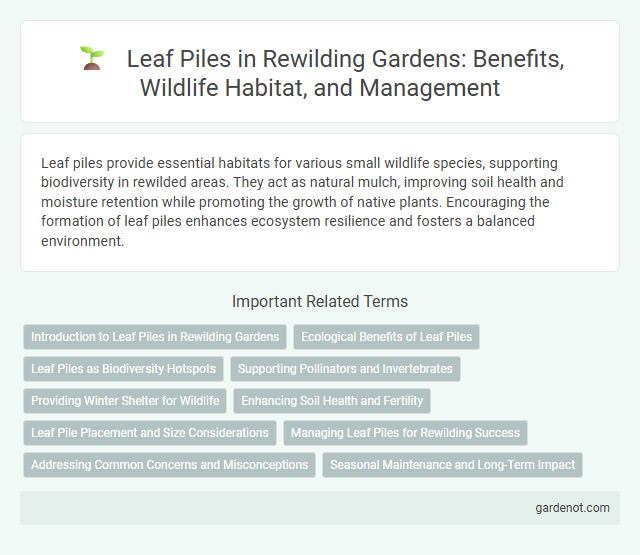Leaf piles provide essential habitats for various small wildlife species, supporting biodiversity in rewilded areas. They act as natural mulch, improving soil health and moisture retention while promoting the growth of native plants. Encouraging the formation of leaf piles enhances ecosystem resilience and fosters a balanced environment.
Introduction to Leaf Piles in Rewilding Gardens
Leaf piles serve as essential microhabitats in rewilding gardens, providing shelter and nourishment for insects, amphibians, and small mammals. These natural compost heaps enhance soil fertility by breaking down organic matter, promoting biodiversity and supporting native flora growth. Integrating leaf piles encourages ecosystem balance and fosters a thriving, resilient garden environment.
Ecological Benefits of Leaf Piles
Leaf piles provide essential habitats for a variety of wildlife, including insects, amphibians, and small mammals, promoting biodiversity in local ecosystems. As these leaf piles decompose, they enrich the soil with organic matter, improving nutrient cycling and supporting plant growth. They also help retain moisture and protect the ground from erosion, contributing to healthier, more resilient ecosystems.
Leaf Piles as Biodiversity Hotspots
Leaf piles serve as critical biodiversity hotspots by providing shelter, food, and breeding grounds for a wide array of organisms such as insects, amphibians, and small mammals. The decomposition of leaves enriches soil nutrient cycling and supports fungi and microbial communities essential for ecosystem health. Preserving or creating leaf piles in rewilding projects enhances habitat complexity and promotes ecological resilience.
Supporting Pollinators and Invertebrates
Leaf piles create essential microhabitats that support diverse pollinators and invertebrates by providing shelter and breeding grounds. These natural decomposing layers enrich soil nutrients, fostering native plant growth which attracts more pollinators like bees and butterflies. Maintaining leaf piles enhances biodiversity and strengthens ecosystem resilience through increased habitat complexity.
Providing Winter Shelter for Wildlife
Leaf piles offer essential winter shelter for wildlife by creating insulated microhabitats that protect small mammals, insects, and amphibians from harsh cold temperatures. These natural debris accumulations retain moisture and provide camouflage, fostering biodiversity and supporting ecological balance. Maintaining leaf piles in rewilded areas enhances habitat complexity and promotes survival rates during winter months.
Enhancing Soil Health and Fertility
Leaf piles create a natural mulch that enriches soil with essential nutrients, fostering microbial activity and improving soil structure. Decomposing leaves release organic matter, which enhances soil fertility and moisture retention crucial for plant growth. These piles also support habitat diversity by providing shelter for decomposers, which further accelerates nutrient cycling in rewilding projects.
Leaf Pile Placement and Size Considerations
Leaf pile placement impacts wildlife habitat by providing shelter for insects, small mammals, and amphibians. Optimal leaf pile size ranges from 1 to 3 feet in height and width, offering adequate cover while preventing moisture buildup that can lead to mold. Positioning leaf piles near native shrubs or undisturbed areas enhances biodiversity and supports natural ecosystem processes.
Managing Leaf Piles for Rewilding Success
Managing leaf piles effectively supports rewilding by creating essential habitats for insects, amphibians, and small mammals, promoting biodiversity. Leaf piles should be left undisturbed in shaded, sheltered areas to maximize shelter and food sources, enhancing ecosystem health. Regular monitoring ensures piles remain beneficial, preventing excessive buildup that could hinder plant growth or attract pests.
Addressing Common Concerns and Misconceptions
Leaf piles provide essential habitat for insects, amphibians, and small mammals, contributing to local biodiversity and soil health by enhancing nutrient cycling. Contrary to common concerns, leaf piles do not significantly increase pests or diseases when properly managed and can reduce garden waste by decomposing naturally. Maintaining a balanced size and location prevents fire hazards and promotes a healthy ecosystem within rewilding projects.
Seasonal Maintenance and Long-Term Impact
Leaf piles serve as vital habitats for insects, amphibians, and small mammals during the colder months, enhancing biodiversity through seasonal maintenance. Regularly managing leaf accumulation prevents excessive buildup that can smother native plants while preserving the ecological benefits of decomposing organic matter. Over time, decomposed leaf piles enrich soil fertility and structure, promoting resilient plant growth and supporting a balanced ecosystem in rewilding projects.
Leaf pile Infographic

 gardenot.com
gardenot.com